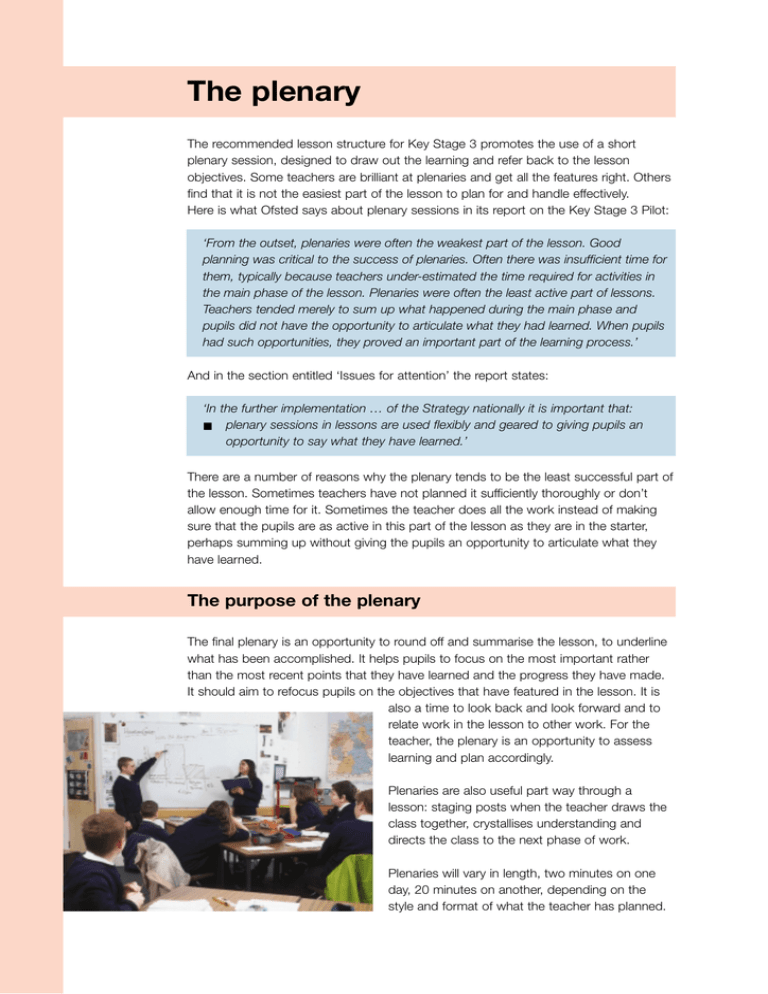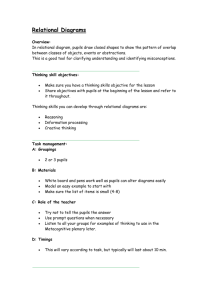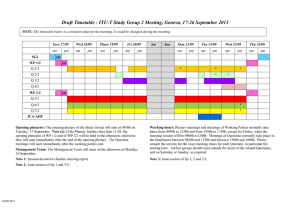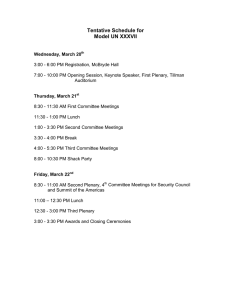The plenary
advertisement

The plenary The recommended lesson structure for Key Stage 3 promotes the use of a short plenary session, designed to draw out the learning and refer back to the lesson objectives. Some teachers are brilliant at plenaries and get all the features right. Others find that it is not the easiest part of the lesson to plan for and handle effectively. Here is what Ofsted says about plenary sessions in its report on the Key Stage 3 Pilot: ‘From the outset, plenaries were often the weakest part of the lesson. Good planning was critical to the success of plenaries. Often there was insufficient time for them, typically because teachers under-estimated the time required for activities in the main phase of the lesson. Plenaries were often the least active part of lessons. Teachers tended merely to sum up what happened during the main phase and pupils did not have the opportunity to articulate what they had learned. When pupils had such opportunities, they proved an important part of the learning process.’ And in the section entitled ‘Issues for attention’ the report states: ‘In the further implementation … of the Strategy nationally it is important that: ■ plenary sessions in lessons are used flexibly and geared to giving pupils an opportunity to say what they have learned.’ There are a number of reasons why the plenary tends to be the least successful part of the lesson. Sometimes teachers have not planned it sufficiently thoroughly or don’t allow enough time for it. Sometimes the teacher does all the work instead of making sure that the pupils are as active in this part of the lesson as they are in the starter, perhaps summing up without giving the pupils an opportunity to articulate what they have learned. The purpose of the plenary The final plenary is an opportunity to round off and summarise the lesson, to underline what has been accomplished. It helps pupils to focus on the most important rather than the most recent points that they have learned and the progress they have made. It should aim to refocus pupils on the objectives that have featured in the lesson. It is also a time to look back and look forward and to relate work in the lesson to other work. For the teacher, the plenary is an opportunity to assess learning and plan accordingly. Plenaries are also useful part way through a lesson: staging posts when the teacher draws the class together, crystallises understanding and directs the class to the next phase of work. Plenaries will vary in length, two minutes on one day, 20 minutes on another, depending on the style and format of what the teacher has planned. To provide the necessary variety, plenaries can be used to: ■ draw together what has been learned, to highlight the most important rather than the most recent points, to summarise key facts, ideas and vocabulary, and stress what needs to be remembered; ■ generalise from examples generated earlier in the lesson; ■ go through an exercise, question pupils and rectify any remaining misunderstandings; ■ make links to other work and what the class will go on to do next; ■ highlight not only what pupils learn but how they have learned; ■ highlight the progress pupils have made and remind them about their personal targets; ■ set homework to extend or consolidate class work and prepare for future lessons. In drawing the lesson together, the vital part is helping pupils to think about what they may have learned by getting them to work briefly on or to summarise the ideas in the lesson. There are many different ways to do this but the essential common feature is that pupils create their own summaries, and are prompted to explain what they have been doing and have learned. The teacher will need to lead discussion of the pupils’ contributions but a summary by the teacher alone rarely helps active learning. Using this leaflet with schools Here are some suggestions for ways in which you could use this leaflet in your work with schools in order to promote more effective use of the plenary session: 1. Introduce the issue raised by Ofsted at a department meeting, and ask teachers to work in pairs to identify three key purposes for the plenary. Use the points in the first box above in feedback to focus on the underpinning rationale. 2. Invite teachers to identify some of the common problems associated with running effective plenaries. Use their feedback as the basis for considering the suggestions in the second box on the back of this leaflet. 3. Invite teachers to select three different approaches to organising a plenary to trial in lessons and to report back at a future meeting. 4. Different approaches will be best suited to different topics and possibly subjects. Following discussion of the purpose of the plenary and consideration of possible approaches, teachers representing a range of subjects trial approaches and write up brief case study notes for dissemination more widely within the school. 5. The TLF training materials, currently being trialled in pilot schools, contain a module that deals specifically with the plenary. It features video of plenary sessions and additonal guidance, including a useful set of overhead transparency masters and handouts. The module will be available for roll-out training in the Autumn Term. This leaflet could be used for teachers to take away following this training. The panel below illustrates some suggestions for involving pupils actively in the final plenary. To involve pupils in the plenary you could: ■ give a hint at the start of the lesson of how the plenary will go, e.g. tell two pupils at the start of the lesson that they will be responsible for reporting back at the end of the lesson on what was important about it – other pupils can then say whether they agree or disagree and why; ■ put the questions you are going to ask in the plenary on the board at the start of the lesson; ■ select pupils to present an aspect of their work to the class, but ‘stop the clock’ at times to ask others in the class to reflect on features which focus back on the lesson objective; ■ use drama strategies, e.g. ■ – put a pupil in a ‘hot seat’ as an expert or character, and invite the rest of the class to ask questions; – ask a group of four pupils to create a ‘still frame’ to show a key idea from the lesson; ask individuals to: ■ – write down three facts they have learned in the lesson, then share these with a partner and add to the list; – think of an important question to ask the rest of the class to test their understanding; – write a sentence that summarises the lesson, then share with a partner; – write key words and definitions in a subject dictionary; – use writing or talking frames designed for the plenary, such as ‘What I found difficult or easy was …’, ‘The most important part was …’, ‘I need to improve on …’; – move as ‘envoys’ from their group to the next to explain a key idea or present some findings; ask pupils in pairs or small groups to: ■ – make a set of word cards drawing on the key vocabulary used in the lesson, putting words on one card and definitions on another, then use the cards to play Pelmanism; – compose two sentences that describe the main ideas of the lesson; – identify three ways in which ideas in the lesson might be used in other subjects; – design one page of a PowerPoint presentation, with a heading and three bullet points summarising an aspect of the lesson; for homework, ask pupils to: – prepare a quiz on the theme of the lesson to try out on the rest of the class; – write a description of the lesson, what they most liked about it (and least), what they found easiest about it, and what was most difficult; – design an exercise for a textbook to follow up work done in the lesson; – design a web page to help remember one aspect of today’s lesson – when you review the homework, ask why they thought certain aspects were important. Copies of this document are available from: © Crown copyright 2002 DfES Publications Tel 0845 60 222 60 Fax 0845 60 333 60 Textphone 0845 60 555 60 e-mail dfes@prolog.uk.com Produced by the Department for Education and Skills Ref: DfES 0192/2002 Extracts from this document may be reproduced for noncommercial or training purposes on the condition that the source is acknowledged www.standards.dfes.gov.uk www.dfes.gov.uk





